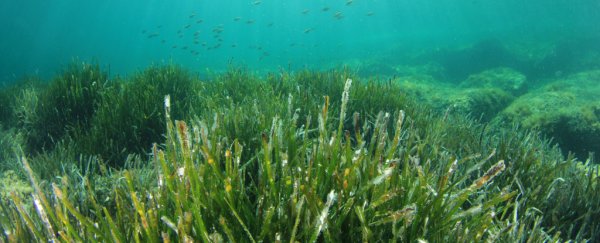For the first time, researchers have found evidence that underwater ecosystems have pollinators that perform the same task as bees on land.
Just like their terrestrial cousins, grasses under the sea shed pollen to sexually reproduce. Until now, biologists assumed the marine plants relied on water alone to spread their genes far and wide. But the discovery of pollen-carrying 'bees of the sea' has changed all of that.
Over several years from 2009 to 2012, researchers from the National Autonomous University of Mexico filmed the spring nocturnal wanderings of crustaceans among beds of turtle seagrass, Thalassia testudinum.
Looking through the videos, they spotted more invertebrates visiting male pollen-bearing flowers than those that lacked pollen – just like bees hovering around pollen-producing plants on land.
"We saw all of these animals coming in, and then we saw some of them carrying pollen," lead researcher Brigitta van Tussenbroek told New Scientist.

The concept was so new, they invented a new term to describe it: zoobenthophilous pollination. Before that, researchers had never predicted that animals were involved in pollinating marine plants.
Wondering if the invertebrates were actually pollinating the seagrasses, or just feeding on it, van Tussenbroek and her team added an assortment of tiny crustaceans to an aquarium of turtle-grass.
In minutes, pollen had appeared on the female flowers, compared with no transfer in the control tank that didn't have crustaceans in it. The take home message was clear: tiny crustaceans were carrying pollen from flower to flower, helping to fertilise them. In the wild, they think this happens in addition to pollination via water currents.
So what's going on here? It's likely that the animals are attracted to the sticky pollen made by the male flowers of seagrass, rather than having any charitable incentive. Gorging on their meal, pollen clings to the crustaceans' bodies, where it is transferred to other flowers as they continue to feed, just like bees.
So far, the researchers have only shown this relationship with turtle-grass, which have large flowers. It's yet to be seen if the other 60-odd species of seagrass also rely on 'sea bees' to carry their pollen.
Kelly Darnell from the non-profit research group The Water Institute of the Gulf told New Scientist:
"That pollination by animals can occur adds an entirely new level of complexity to the system, and describes a very interesting plant-animal interaction that hasn't really fully been described before."
It's no secret that coastal meadows of seagrass are immensely important ecosystems. Not only do they support diverse communities of animal, from tiny crustaceans to large marine mammals like the dour-faced dugong, but their roots also hold onto sediment and prevent erosion.
Given it takes two hectares of tropical forest to match the carbon contained within a single hectare of seagrass, ecologists are now recognising the significance of their 'blue carbon' reserves.
Unfortunately, hidden beneath the waves, our blue ecosystems are often overlooked. Knowing how communities of plants and animal interact in our coastal environments will be important if we're to have a good shot at protecting them.
This research was recently published in the journal Nature Communications.
